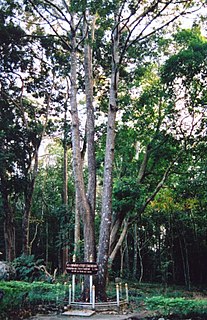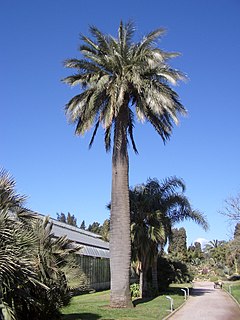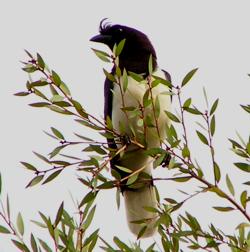
The yellow-headed caracara is a bird of prey in the family Falconidae. It is found in tropical and subtropical South America and the southern portion of Central America. Unlike the falcons in the same family, the caracara is not a fast-flying aerial hunter, but is rather sluggish and often obtains food by scavenging.

Shorea is a genus of about 196 species of mainly rainforest trees in the family Dipterocarpaceae. The genus is named after Sir John Shore, the governor-general of the British East India Company, 1793–1798. The timber of trees of the genus is sold under the common names lauan, luan, lawaan, meranti, seraya, balau, bangkirai, and Philippine mahogany.

Prosopis nigra is a South American leguminous tree species that inhabits the Gran Chaco ecoregion, in Argentina and Paraguay. It is known as algarrobo negro in Spanish, which means "black carob tree". It is also variously called algarrobo dulce, algarrobo morado and algarrobo amarillo.

Jubaea is a genus of palms with one species, Jubaea chilensis or Jubaea spectabilis, commonly known in English as the Chilean wine palm or Chile cocopalm, and palma chilena in Spanish. It is native to southwestern South America and is endemic to a small area of central Chile between 32°S and 35°S in southern Coquimbo, Valparaíso, Santiago, O'Higgins, and northern Maule regions.

Caryocar is a genus of flowering plants, in the South American family Caryocaraceae described as a genus by Linnaeus in 1771. It is native primarily to South America with a few species extending into Central America and the West Indies.

Dekeyser's nectar bat is a bat species from South America. It is found in Brazil and Bolivia.

The South American coati, also known as the ring-tailed coati, and called quati in Portuguese, is a coati species and a member of the raccoon family (Procyonidae), found in the tropical and subtropical parts of South America. An adult generally weighs from 2–7.2 kg (4.4–15.9 lb) and is 85–113 cm (33–44 in) long, with half of that being its tail. Its colour is highly variable and the rings on the tail may be only somewhat visible, but its most distinguishing characteristic is that it lacks the largely white snout of its northern relative, the white-nosed coati.

The curl-crested jay is a jay from South America.

Caryocar nuciferum, the butter-nut of Guiana, is also known as pekea-nut, or – like all other species of Caryocar with edible nuts – "souari-nut" or "sawarri-nut". It is a fruit tree native to northern Brazil, Colombia, Costa Rica, Guyana, Panama, and Venezuela.
Syagrus smithii is a species of palm tree found in Brazil, Colombia, Ecuador and Peru.

Arbutus xalapensis, commonly known as the Texas madrone, naked Indian tree or Texas madroño, is a species of flowering plant in the heather family. It is native to Central America, the southwestern United States, and throughout Mexico. It is found in canyons and mountains, on rocky plains, and in oak woodlands, at altitudes of up to 3,000 m in the south of the range, but lower, down to 600 m in the north of the range.
Caryocar coriaceum is a species of plant in the Caryocaraceae family. It is endemic to Brazil.

Caryocar costaricense is a species of plant in the Caryocaraceae family. It is found in Colombia, Costa Rica, Panama, and Venezuela. It is threatened by habitat loss.
Ficus pulchella is a species of tree in the family Moraceae. It is native to South America.

Ficus trigonata is a species of tree in the family Moraceae. It is native to North America and South America.
Pouteria juruana is a species of tree in the family Sapotaceae. It is native to North and South America.

Pterocarpus santalinoides is a tree species in the legume family (biology) (Fabaceae); it is locally known as mututi.

Caryocar brasiliense, known as pequi or "souari nut", like its congeners, is an edible fruit popular in some areas of Brazil, especially in Centerwestern Brazil.

Caryocar glabrum is a species of tree in the family Caryocaraceae. It is native to South America.

Protea glabra, also called the Clanwilliam sugarbush, is a flowering shrub belonging to the genus Protea.














